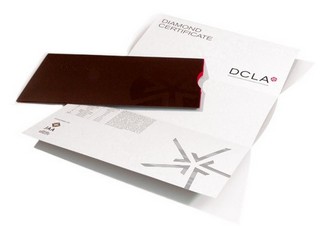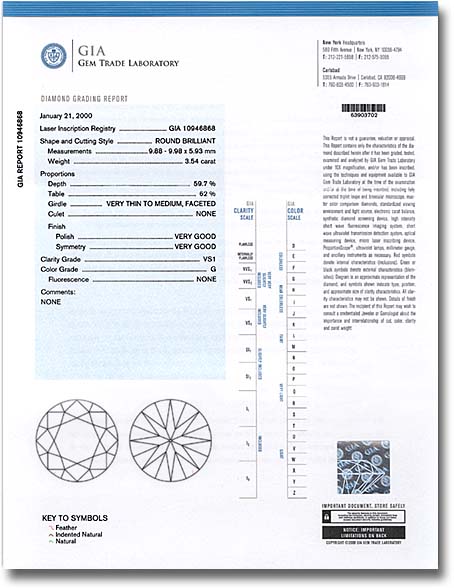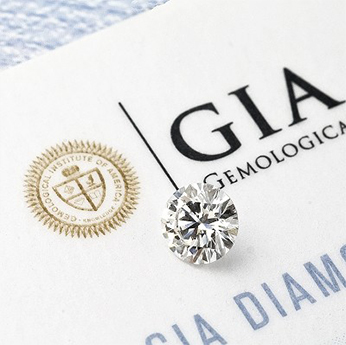
Diamond Certificate or Diamond Report
A diamond certificate, also known as a diamond grading report, is an official document issued by a gemological laboratory that provides an objective assessment of a diamond’s quality. It evaluates key characteristics such as carat weight, cut, colour, clarity, and other essential factors.
What a Diamond Certificate Includes:
A diamond grading report typically contains:
Carat Weight – The precise weight of the diamond in carats (ct).
Cut Grade – Evaluates how well the diamond is cut, affecting its brilliance and fire.
Colour Grade – Ranges from D (colourless) to Z (light yellow or brown).
Clarity Grade – Assesses internal inclusions and external blemishes, from Flawless (FL) to Included (I3).
Shape & Measurements – Specifies the diamond’s shape (e.g., round, oval) and dimensions in millimeters.
Fluorescence – Indicates if the diamond glows under UV light, which may impact its appearance.
Symmetry & Polish – Evaluates the precision of the diamond’s cut and surface quality.
Inclusion Plot (Clarity Map) – A diagram showing the locations of inclusions and blemishes.
Security Features – Some certificates include laser inscription of the report number on the diamond’s girdle for verification.
Recognised Diamond Certification Laboratories
Reputable gemological laboratories that provide independent, accurate, and unbiased diamond grading include:
GIA (Gemological Institute of America) – The most respected and widely recognised grading authority worldwide.
AGS (American Gem Society) – Known for its strict grading standards, particularly for cut quality.
HRD (Hoge Raad voor Diamant) – A leading European gem lab based in Antwerp, Belgium.
IGI (International Gemological Institute) – Commonly used in the retail diamond market.
EGL (European Gemological Laboratory) – Offers looser grading standards compared to GIA and AGS.
DCLA (Diamond Certification Laboratory of Australia) – The only independent diamond grading laboratory in Australia, known for its strict and accurate grading.
The GIA a gemmological organisation will be conducting a seven week graduate diamond diploma from January 8.
The programme combines theory lessons with practical hands on learning and will be held in Jaipur.
Students will learn how to grade in accordance with the GIA’s 4Cs colour, cut, clarity and carat weight of diamond in the D-Z colour range.
As well as how to grade diamonds and detect simulants and treatments like fracture filled diamonds using gemmological equipment.
The course will be taught by instructors from the Mumbai campus.

The Gemological Institute of America (GIA) has identified and seized a bogus diamond grading report appearing recently in Hong Kong.
In a news release issued on Wednesday, GIA revealed that although the number of the diamond grading report was in existence in their database, it corresponded to a higher-quality diamond with different measurements, colour, and clarity. According to GIA, a lower quality diamond was cut to match the specifications of the diamond that went with the original report. Furthermore, GIA stated that upon closer scrutiny of the false diamond grading certificate, it was discovered that there were several characteristics inconsistent with those found on an authentic GIA diamond grading report, including differences in font, colour, and background.
In the same release, GIA revealed that their investigation had tracked the counterfeit diamond certificate back to Antwerp, Belgium, a major diamond trading center. Information on the perpetrators is now being sought by the GIA, who is working law enforcement authorities around the world to help detect and prosecute such criminal activities. GIA asks that any individuals with information about either this particular bogus certificate or any other fraudulent activity bring it to their attention.
To help both the industry and public, all major laboratories provide an online database service that allows individuals to check the authenticity of a diamond certificate online by entering the diamond report number and the carat weight of the diamond, which then pulls up all available information about the diamond.
However, this online verification service only serves to determine if the certificate number exists, not if the diamond that accompanies it matches the certificate. GIA offers a verification service to confirm the authenticity of a diamond grading report whereby clients must submit both the diamond and certificate to the GIA laboratory.
In Australia, DCLA performs this verification service and individuals may bring their diamond and accompanying diamond certificate to the DCLA for verification; please contact the laboratory for more information.



